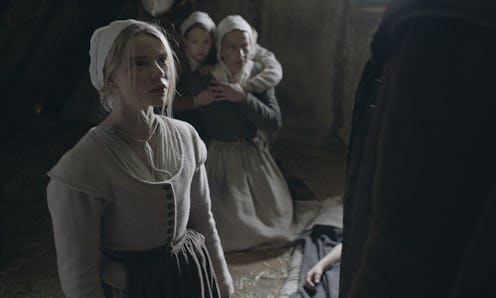
It's been almost 17 years since a different kind of witch terrorized a group of young filmmakers in the Maryland woods in the found footage film The Blair Witch Project. The upcoming horror release The Witch may owe at least a debt of audience interest to the indie smash, though the 2016 film trades Blair Witch's modern context for a frighteningly authentic 17th century setting. The Witch follows a Puritan family from town to their new home in the desolate New England wilderness. In solitude and under siege by some type of supernatural force, the family spirals into madness and destructive distrust. (In other words: the perfect date movie!) Any graduate of middle school knows that witchcraft paranoia figures in to an embarrassing period of American history, and that many innocent civilians were accused of consorting with the devil and hanged for their crimes. Is The Witch based on a true story from the past? At the very least, the fear it recreates is real.
Director Robert Eggers is a native New Englander, and told Indie Wire that The Witch was born from his childhood obsession with the occult. "Growing up, we always had stories of the witch in the woods or the witch down the block," Eggers said. "I tried to go to Salem every Halloween and I was always disappointed that the witches weren’t real." Honestly, after watching the movie's trailer, that statement is a bit of a relief. Though Eggers may not believe in his subject any more, he did call on recorded claims of witchcraft as source material. Eggers said:
We looked at fairy tales and folk tales, but also diaries and accounts of real witchcraft and court records, and you see the same tropes throughout, the same witch...If I could take a Puritan’s nightmare as I would envision it and upload it into the audience’s mind’s eye, that was the goal.
Reality is as subjective as ever, so it's the position that the movie takes on these records and oral histories that will strike terror into the hearts of audiences. There may be perfectly rational explanations for the events as written, but, hey, where's the fun in that? In an interview with Slash Film, Eggers credited the four years it took to cobble together the movie's funding for affording him the time to painstakingly research the period and its fears. In addition to consulting with historians and visiting museums on the subject matter, Eggers insisted on physical period accuracy wherever possible, right down to the most minute details. "The clothing is all based on patterns from extant clothing, it’s all hand-stitched, hand-woven," Eggers said. "Everything that you see on the farm in camera is the correct materials, which often meant we had to use the period tools to make the stuff."
The Witch, though it carries the subtitle "A New England Folktale," might qualifiy as a type of historical fiction — one that uses accuracy to psychological effect. Its authenticity is designed to transport the audience to a time where horrors that seem quaint now were very present and very real. So real that the director himself sees reason to believe them. "Because witches don’t exist today," Eggers told Slash Film, "I felt it was essential to create an utterly believable 17th century world where witches really did exist." If The Witch is successful in displacing you in time, you might walk out of the theater believing in them too.
Image: A24; Giphy